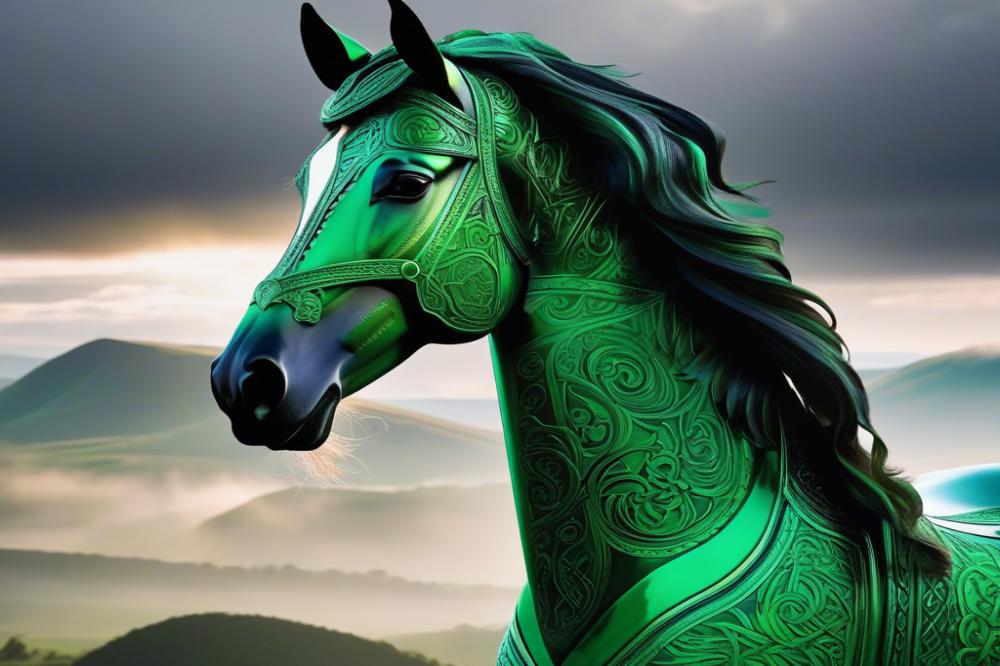Horses in Celtic mythology
Celtic culture holds a deep appreciation for horses. These majestic creatures are often seen as symbols of power, freedom, and connection to the divine. Various cultures throughout history have revered horses, but in Celtic mythology, their significance reaches profound heights.
In Druid beliefs, horses were deemed sacred animals, embodying traits that were admired and respected. They weren’t just modes of transportation; they represented the bridge between the earthly realm and the world of spirits. Within myths, these animals often played crucial roles. Many stories feature them as companions to gods and heroes, guiding them on their quests.
The importance of horses can also be seen in the artwork and artifacts of the Celts. Ancient carvings and inscriptions frequently depicted these animals, showcasing their vital place in daily life and spiritual practices. The Celts understood that horses carried both physical and symbolic weight, reflecting their values and beliefs.
Folklore further emphasizes the connection between horses and the mystical. Tales abound of enchanted horses that could traverse land and sea, or those that could grant wishes to those pure of heart. These legends illustrate how intertwined the idea of horses is with magic and reverence in Celtic society.
In summary, Celtic horses symbolize more than mere transport; they encapsulate the culture’s spiritual beliefs. Their esteemed status as sacred creatures continues to resonate, highlighting a rich heritage that values connection, strength, and the mysteries of life.
Celtic horses: sacred animals in Celtic Mythology
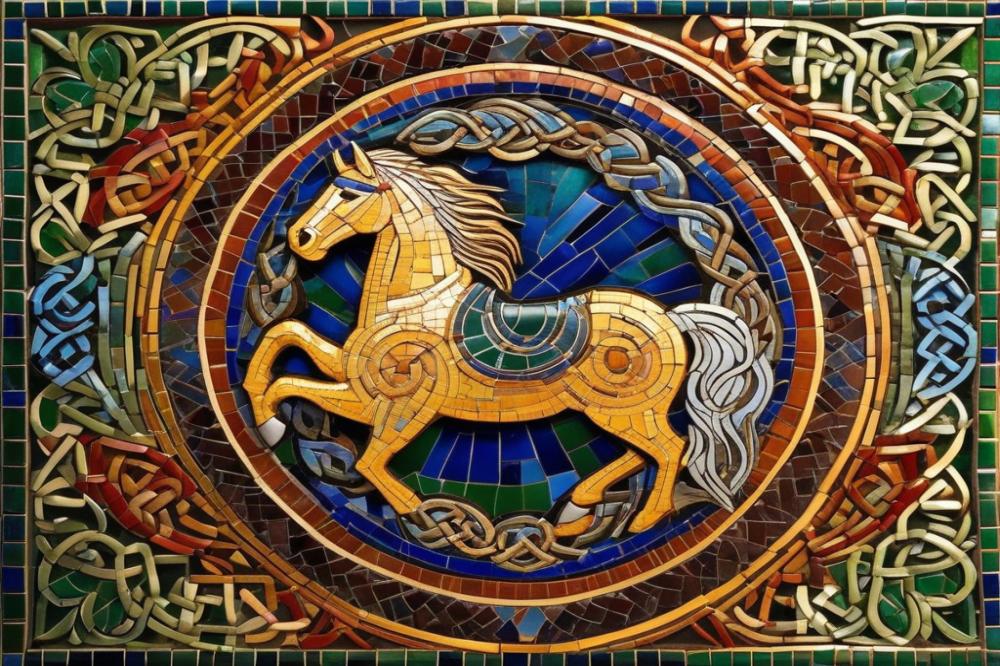
The importance of horses in Celtic mythology cannot be overstated. In ancient Celtic culture, these animals played crucial roles as symbols of strength, freedom, and status. Celts revered them, seeing them as more than mere beasts of burden. Instead, horses often embodied spiritual power and connection to the otherworld.
These majestic creatures were intertwined with various deities and legends. In the minds of the Celts, they represented the journey between life and death, often guiding souls in the afterlife. This belief was prevalent across different tribes and regions, showcasing a widespread respect for horses.
Several prominent mythological horses stand out in Celtic tales. One such horse is the magnificent Steed of the Goddess Epona. Known as the protector of horses, Epona symbolized fertility and abundance. People often dedicated altars to her, seeking blessings for their herds. Devotion to her illustrates how vital horses were to agricultural life.
Another notable figure is the wondrous horse of the deity Lugh, called Aonbharr. This magnificent animal had the ability to traverse any terrain at incredible speed, representing swiftness and agility. Lugh, known for his many skills, rode Aonbharr into battle, emphasizing the bond between warrior and steed.
The supernatural aspects of these animals were evident in tales like that of the enchanted horses in the story of Cú Chulainn. In some accounts, they could even speak and share wisdom. Their magical qualities created a connection between the mundane world and the mystical realm.
Additionally, horses were often depicted as companions in battle and in daily life. Warriors would boast about their steeds, believing that a fine horse brought honor and valor. This relationship was deeply ingrained in Celtic identity, as riding and horsemanship were seen as key skills.
In many stories, the appearance of a horse signaled a turning point. They were associated with prophecies and omens. Some believed that seeing a white horse foretold great fortune, while others saw dark horses as harbingers of change or misfortune. With such beliefs, it is clear that horses held a unique place in the Celtic imagination.
Overall, horses were sacred beings in Celtic myth and culture. Their presence in various tales illustrates the deep respect the Celts had for them. This connection between horses and the divine reflects a profound understanding of life, death, and the cycles of nature.
Equine Symbolism in Celtic Culture
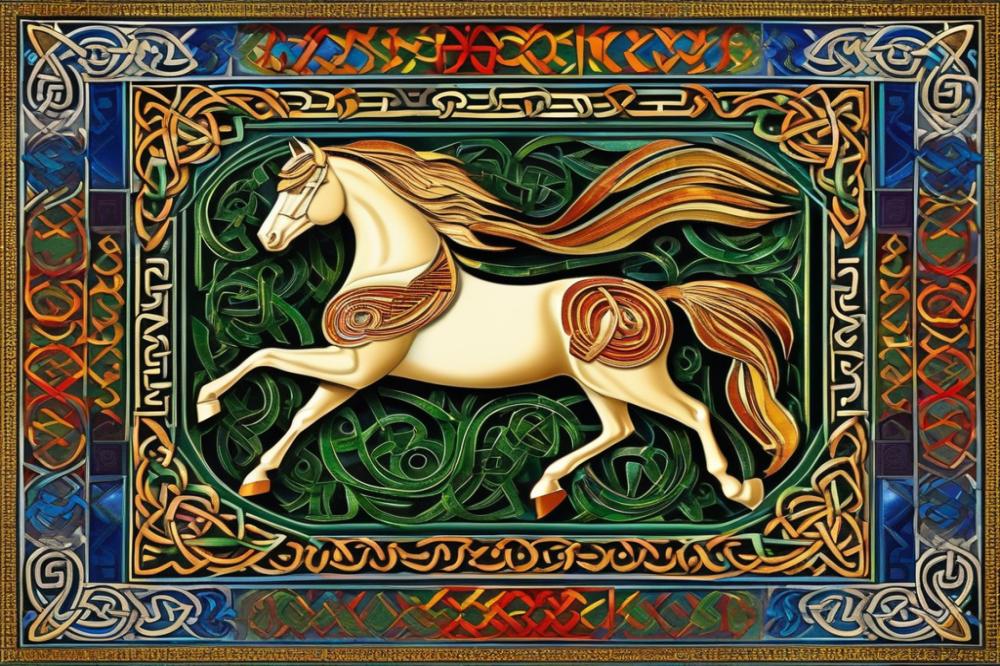
Horses held a prominent position in Celtic culture. They were symbols of freedom and strength, representing the untamed spirit of nature. These majestic animals inspired awe and respect among the Celts. Their stature conveyed nobility and power. To many, horses were more than mere companions; they were vital to life and lore.
In various rituals, horses played an essential role. They often appeared in ceremonies meant to invoke prosperity and success. When warriors sought victory, it was common for them to turn to these creatures for blessings. The presence of a horse in battle was thought to increase a fighter’s bravery and skill. Thus, horses became inseparable from the concept of heroism.
Magic surrounded horses in Celtic folklore. They were often depicted as otherworldly beings, with the ability to traverse realms. Some tales describe magical steeds that could fly or gallop across water. These stories stirred the imagination, inviting people to see horses as more than just animals. In many instances, they embodied the connection between the earthly and the supernatural.
Various deities were associated with horses, further enhancing their mystical aura. Gods and goddesses often rode magnificent steeds in Celtic mythology. Figures like Epona, the protector of horses, highlighted their sacred status. This reverence extended to horse funerals and burial practices, which reflected deep respect for these animals.
In addition to their spiritual significance, horses served practical purposes. They were essential for transportation, agriculture, and warfare. Their utility was matched only by their symbolic weight. This duality made them crucial to daily life and the mythological landscape. As companions, they offered loyalty and friendship, and as symbols, they represented the ideals of Celtic society.
Ultimately, equine symbolism in Celtic culture illustrates a rich tapestry of meanings. Strength, freedom, and magic are woven together, creating a profound connection with these magnificent creatures. Understanding this connection offers insight into the beliefs and values of the Celts. Their legacy continues to resonate and intrigue those who explore it.
Mythological Horses and Their Legends
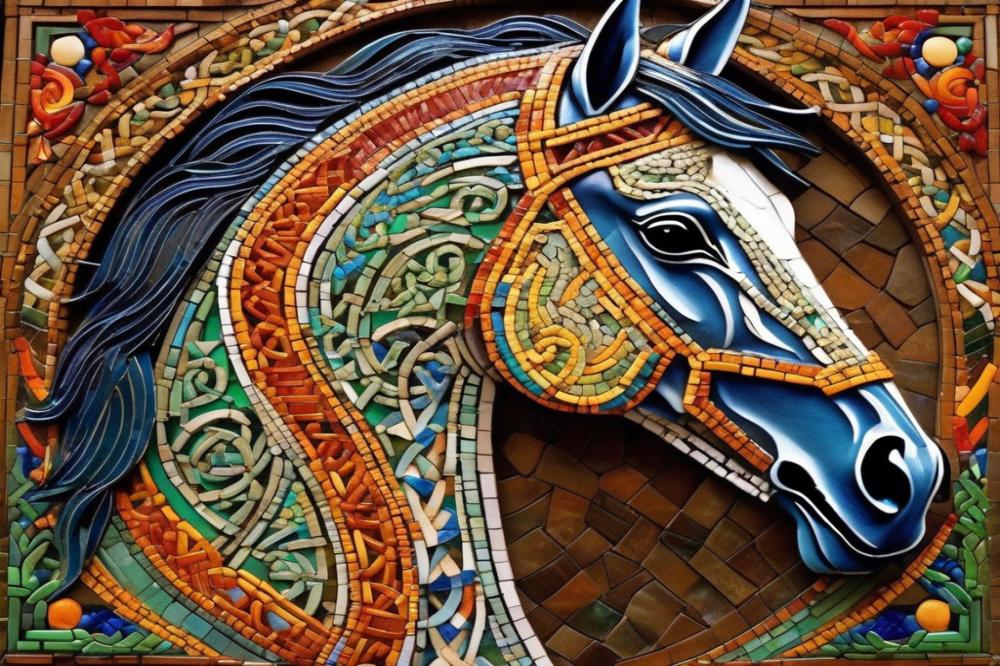
In Celtic mythology, horses often carry deep symbolic meanings. They are revered as sacred animals connected to various deities and mythical tales. One of the most important figures is Epona. She is the goddess of horses, riders, and agriculture. Epona appears as a protector of horses and is often depicted with a mare. Celebrated primarily in Gaul, her influence extends to the entire Celtic world.
Another notable horse from mythology is the magnificent steed of the hero Cú Chulainn. Known as the “Brown Bull of Cooley,” this creature’s immense strength and loyalty play a significant role in the epic tale of the Táin Bó Cúailnge. The story explores themes of bravery and conflict as Cú Chulainn battles to protect Ulster.
Then, there is the story of the horse Fionn mac Cumhail rides into battle. His formidable horse aids him against the supernatural foes he faces. This legendary horse not only symbolizes strength but also reflects the importance of steeds in warfare during ancient times.
An intriguing aspect to explore is the connection between these horses and the Otherworld. Many legends describe enchanted horses that can transport riders between realms. For example, one tale speaks of a white horse that can ferry individuals to the land of the fairies. Riders seeking adventure or mystical experiences often long for such a journey.
Additionally, the goddess Rhiannon is a captivating figure. In her stories, she is associated with a magical horse that symbolizes both power and grace. Rhiannon is known for her ability to enchant those who pursue her. Her tales often blend themes of love, loss, and transformation.
Moreover, the horses of these legends are often portrayed as more than mere animals. They are seen as mystical beings, bestowing gifts or prophecies upon their riders. Some narratives suggest that riding certain sacred horses can lead to extraordinary experiences or insights.
These varied tales highlight the intertwined relationship between horses and humanity in Celtic culture. Each legend reflects the respect and veneration that ancient Celts had for these creatures. The stories continue to resonate, revealing timeless themes of courage, mysticism, and reverence for the natural world.
Druid Beliefs and Sacred Horses
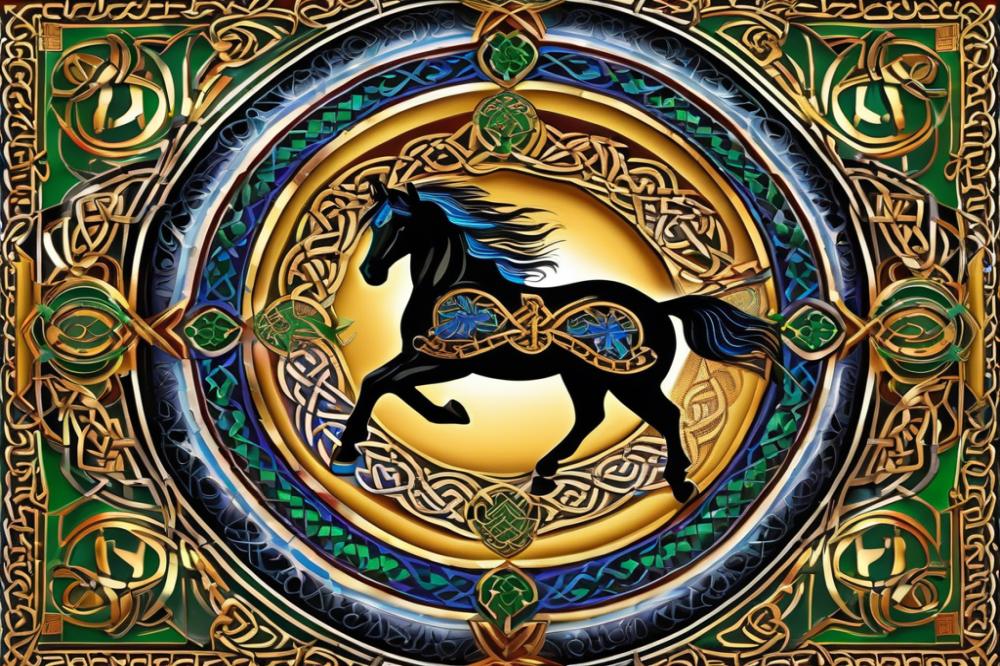
Druids held horses in high esteem. They were seen as sacred animals within ancient Celtic culture. Many believed that horses acted as intermediaries between the human world and the divine. This connection formed a core part of Druidic rituals and beliefs.
During ceremonies, horses often played a central role. They might be used in sacrifices, symbolizing strength and nobility. The presence of a horse could elevate a ritual, making it more powerful. Rituals were performed to honor deities associated with these magnificent creatures.
Moreover, certain horses were thought to possess supernatural qualities. Some legends tell of horses that could traverse realms, bringing messages from the Otherworld. While many cultures have revered animals, the relationship between Druids and horses was particularly profound.
Horses also connected to various Celtic gods. For instance, Epona was worshiped as a goddess of horses, fertility, and protector of travelers. Her influence extended across regions, showcasing the importance of these animals to the Celts. Sacred groves, where Druids met, often featured carvings of horses, emphasizing their spiritual significance.
Additionally, the symbolism of horses encompassed strength and freedom. Druids viewed them not only as animals of burden but as companions in spiritual journeys. This belief reflects a deeper understanding of nature and its interconnectedness.
In storytelling, horses often appeared as magical beings. Tales of shape-shifting or otherworldly steeds were common. Such myths reinforced the idea that horses bridged the gap between life and afterlife. The stories contributed to a rich tapestry of beliefs surrounding these special animals.
In conclusion, the reverence for horses in Druidic thought was multidimensional. Few other animals matched their significance in Celtic spirituality. Understanding these beliefs allows for a deeper appreciation of ancient traditions and their connection to nature.
Celestial Horses in Celtic Mythology
Pivotal to Celtic mythology are horses that transit beyond earthly bounds. These celestial creatures are seen as radiant beings, traversing the skies. Many tales depict them related to the sun and moon, emphasizing their divine qualities.
For instance, some legends portray a mythical horse drawing a chariot across the sky. This chariot, often associated with the sun, brings light to the land. It emphasizes the importance of horses in daily life; they represented vitality and energy. Harnessing the sun’s power, these animals became symbols of life-giving forces.
The moon also ties into equine symbolism. Some horses are linked to lunar deities, promoting ideas of night journeys. These associations suggest that horses could traverse dimensions. They often symbolize transitions, guiding souls from one realm to another. Such themes reflect the belief in the interconnectedness of life and the afterlife.
Celestial horses also represent freedom and hope. Riders often sought enlightenment on their backs, embarking on astral journeys. In those moments, they moved beyond mere physical realms, tapping into spiritual dimensions. It shows that these animals served more than just practical functions in ancient society.
Stars twinkling through the night sky could connect back to these extraordinary beings. Horses were seen as vessels carrying dreams and aspirations. Their celestial links enhanced their status as sacred animals. By associating them with cosmic elements, myths deepened their significance in the culture.
Even in contemporary discussions about Celtic mythology, these heavenly connections linger. People still marvel at the stories of horses and their roles in the cosmos. The continued fascination reflects a deeper understanding of how ancient civilizations viewed their world. Enhancing their legacy, these celestial narratives add layers to the admiration of horses in a spiritual context.
Symbolism in Folklore: Horses as Transformation
Horses hold a significant place in Celtic folklore. They serve as symbols of change and transition. Many stories describe the transformative power of these animals. Legends often depict horses as guides into other realms. These narratives highlight their role in journeys of self-discovery.
In one tale, a rider encounters a magnificent steed that leads him away from his ordinary life. This journey symbolizes growth and the pursuit of one’s true purpose. Upon returning, the rider is not the same as before. The experience alters his perspective, showing how horses facilitate personal evolution.
Transformation in folklore is not always physical. Sometimes, it involves emotional and spiritual changes. For example, a girl might be turned into a horse for a time. She learns valuable lessons during her captivity. Freedom might come with a price, emphasizing the need for sacrifice in personal growth.
Celtic mythology often intertwines horses with the concept of fate. They appear during significant life events, such as births and deaths. Their presence signifies a forthcoming change that individuals must embrace. Various stories illustrate how interacting with these creatures can lead to unforeseen transformations.
Folklore paints horses as the connection between the mortal world and the mystical. They represent the thresholds between realms. Crossing these boundaries often brings unexpected outcomes. Maintaining a relationship with these beings reflects the Celtic value of harmony with nature.
Many tales also show horses as embodiments of strength. They empower heroes to confront challenges and face fears. In some stories, the journey alongside a horse leads to triumphant change. These narratives reinforce the belief that transformation often requires courage and resilience.
Ultimately, horses symbolize profound life changes in Celtic culture. They inspire individuals to seek deeper meanings in their lives. Through stories, they teach lessons about growth, sacrifice, and destiny. The transformative power of horses resonates through generations, remaining a vital aspect of Celtic identity.
Final Thoughts on Sacred Horses in Celtic Mythology
Horses hold a special place in Celtic mythology, serving as much more than mere animals. They are interwoven with stories, beliefs, and cultural practices that define the identity of Celtic people. For ancient Celts, these majestic beings represented strength, freedom, and fertility. Various tales illustrate their profound significance as gateways to the spiritual world.
When we explore legends such as that of the horse goddess Epona, it becomes clear how deeply rooted equine symbolism is in their culture. Epona was not just a deity of horses but also a protector of travelers and a symbol of abundance. Such narratives highlight the belief that horses were sacred and tied to the divine. Their presence in rituals and art reinforces this sacred connection, portraying them as powerful entities that influenced life and death.
The legacy of these sacred animals continues to resonate today. In modern Celtic festivals and cultural practices, horses are still celebrated and revered. They remind us of the intricate relationship between humans and nature in Celtic traditions. Moreover, the bond between horses and people serves as a testament to their enduring nature in folklore and contemporary life.
In conclusion, the role of horses in Celtic mythology transcends their physical form. They embody spiritual significance, connecting communities with their past. This deep-rooted relationship reflects a culture that honors nature and its mysteries. Through understanding these connections, we gain insight into a civilization rich in history and meaning. When we appreciate the power and presence of these animals, we embrace part of what it means to be connected to Celtic heritage.

